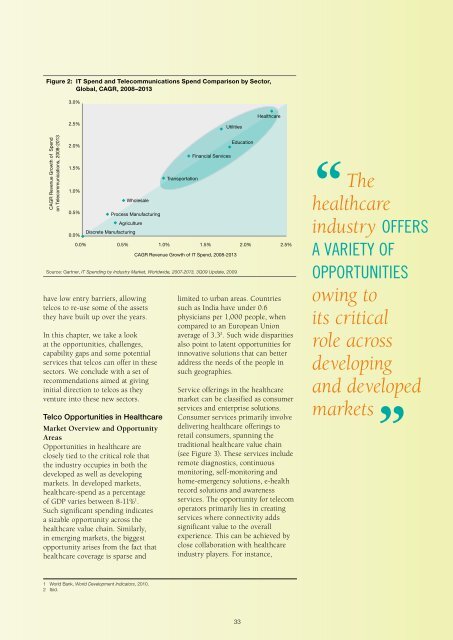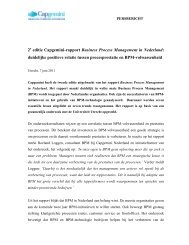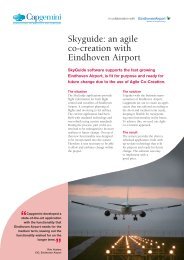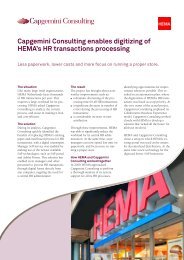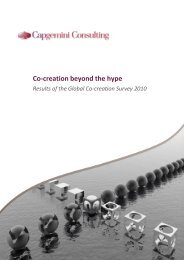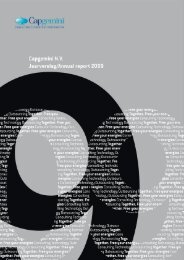IT transformations - Capgemini Consulting Nederland
IT transformations - Capgemini Consulting Nederland
IT transformations - Capgemini Consulting Nederland
You also want an ePaper? Increase the reach of your titles
YUMPU automatically turns print PDFs into web optimized ePapers that Google loves.
Figure 2: <strong>IT</strong> Spend and Telecommunications Spend Comparison by Sector,<br />
Global, CAGR, 2008–2013<br />
3.0%<br />
2.5%<br />
Utilities<br />
Healthcare<br />
CAGR Revenue Growth of Spend<br />
on Telecommunications, 2008-2013<br />
2.0%<br />
1.5%<br />
1.0%<br />
0.5%<br />
0.0%<br />
Wholesale<br />
Process Manufacturing<br />
Agriculture<br />
Discrete Manufacturing<br />
have low entry barriers, allowing<br />
telcos to re-use some of the assets<br />
they have built up over the years.<br />
In this chapter, we take a look<br />
at the opportunities, challenges,<br />
capability gaps and some potential<br />
services that telcos can offer in these<br />
sectors. We conclude with a set of<br />
recommendations aimed at giving<br />
initial direction to telcos as they<br />
venture into these new sectors.<br />
Telco Opportunities in Healthcare<br />
Market Overview and Opportunity<br />
Areas<br />
Opportunities in healthcare are<br />
closely tied to the critical role that<br />
the industry occupies in both the<br />
developed as well as developing<br />
markets. In developed markets,<br />
healthcare-spend as a percentage<br />
of GDP varies between 8-11% 1 .<br />
Such significant spending indicates<br />
a sizable opportunity across the<br />
healthcare value chain. Similarly,<br />
in emerging markets, the biggest<br />
opportunity arises from the fact that<br />
healthcare coverage is sparse and<br />
Transportation<br />
Financial Services<br />
CAGR Revenue Growth of <strong>IT</strong> Spend, 2008-2013<br />
Education<br />
0.0% 0.5% 1.0% 1.5% 2.0% 2.5%<br />
Source: Gartner, <strong>IT</strong> Spending by Industry Market, Worldwide, 2007-2013, 3Q09 Update, 2009<br />
limited to urban areas. Countries<br />
such as India have under 0.6<br />
physicians per 1,000 people, when<br />
compared to an European Union<br />
average of 3.3 2 . Such wide disparities<br />
also point to latent opportunities for<br />
innovative solutions that can better<br />
address the needs of the people in<br />
such geographies.<br />
Service offerings in the healthcare<br />
market can be classified as consumer<br />
services and enterprise solutions.<br />
Consumer services primarily involve<br />
delivering healthcare offerings to<br />
retail consumers, spanning the<br />
traditional healthcare value chain<br />
(see Figure 3). These services include<br />
remote diagnostics, continuous<br />
monitoring, self-monitoring and<br />
home-emergency solutions, e-health<br />
record solutions and awareness<br />
services. The opportunity for telecom<br />
operators primarily lies in creating<br />
services where connectivity adds<br />
significant value to the overall<br />
experience. This can be achieved by<br />
close collaboration with healthcare<br />
industry players. For instance,<br />
“<br />
The<br />
healthcare<br />
industry offers<br />
a variety of<br />
opportunities<br />
owing to<br />
its critical<br />
role across<br />
developing<br />
and developed<br />
markets<br />
”<br />
1 World Bank, World Development Indicators, 2010.<br />
2 Ibid.<br />
33


